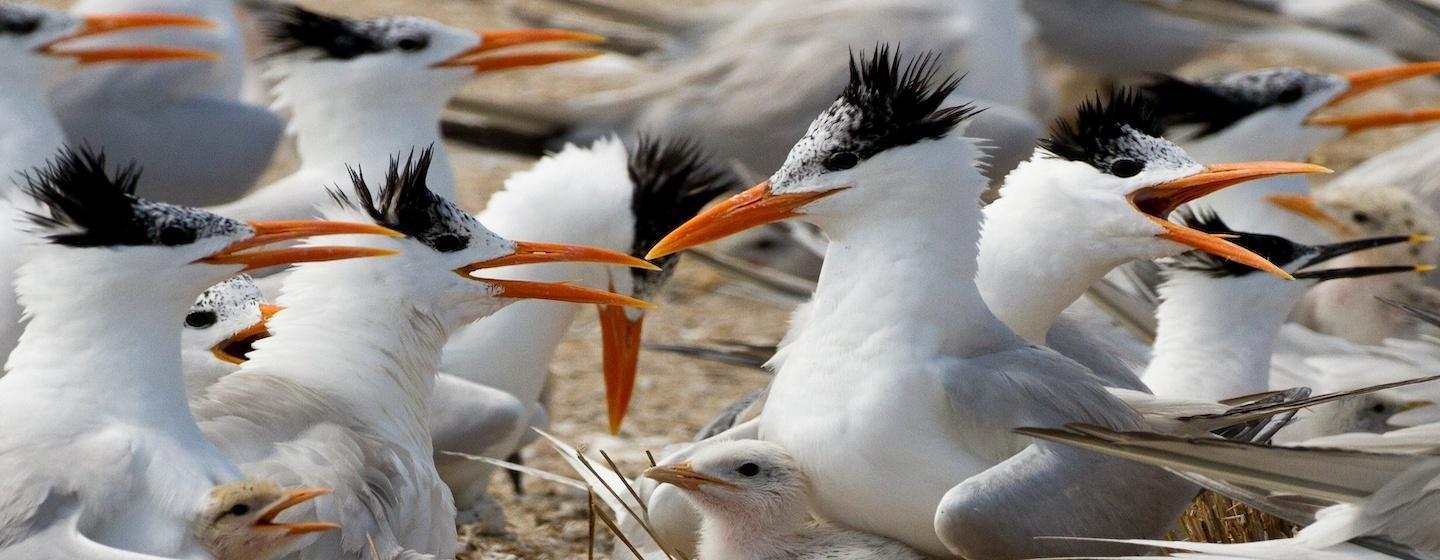Saving An Island To Help Birds And People


Ferry Slip Island sits at the mouth of the Cape Fear River, south of Wilmington. It’s not a natural island. It’s made entirely of dredged material.
But thousands of Royal Terns and Sandwich terns believe it’s a perfect place to raise a family.
“Because Royal and Sandwich Terns nest together in just a few highly concentrated groups, losing even one colony can put the larger population at risk,” said Lindsay Addison, Coastal Biologist at Audubon North Carolina. “Ferry Slip Island has been an incredibly important stronghold for these birds.”
However, sea level rise and stronger storms linked to climate change, combined with the wakes from passing ships, is taking a toll on the island. The five-acre island has lost almost two acres to erosion, roughly 40% of its land, in the past decade.
But a long-awaited project by Audubon North Carolina and the U.S. Army Corps of Engineers will restore the island just in time.
The Army Corps pumped 80,000 cubic yards of dredged sand onto the island. That’s about 8,000 dump truck loads of sand. This material came from a shallow area, or “speed bump,” that had built up in the federal navigation channel and was removed to keep the river’s channel open for the Port of Wilmington.
“We’re grateful that the stars aligned on this project and that we could figure out a way for birds and people to benefit from maintenance dredging on the river,” said Emily Hughes, Biologist at the U.S. Army Corps of Engineers.
The new deposits of dredge material will not only reinforce the island but almost double its size to roughly 7 acres. That will support nesting birds for years to come.
The island’s open, sandy habitat is ideal for Royal and Sandwich Terns, which congregate in huge numbers to nest. More than 3,000 Royal and Sandwich Terns breed on Ferry Slip Island and neighboring South Pelican Island each year.
That’s roughly one fifth of the state’s population on just a few acres of sand. The birds lay eggs in small scrapes in the ground and raise their chicks right on the sand.
The kind of open, isolated habitat these birds need isn’t easy to find. The loss of low natural islands elsewhere along the North Carolina coast along with people flocking to barrier island beaches make dredged-material islands among the last best places for them to nest.
Ferry Slip Island is managed by Audubon through a cooperative agreement with the North Carolina Wildlife Resources Commission as part of the organization’s larger network of coastal sanctuaries. All told, the network provides a safe place to nest and raise chicks for 40 percent of North Carolina’s coastal nesting waterbirds.
The sand-pumping island rescue won’t solve the problem. Erosion from climate change and ship wake will continue. That’s why Audubon is working on a plan and permits to expand Ferry Slip and South Pelican in the future. But for now, those thousands of terns can rest, knowing their sanctuary is secure.